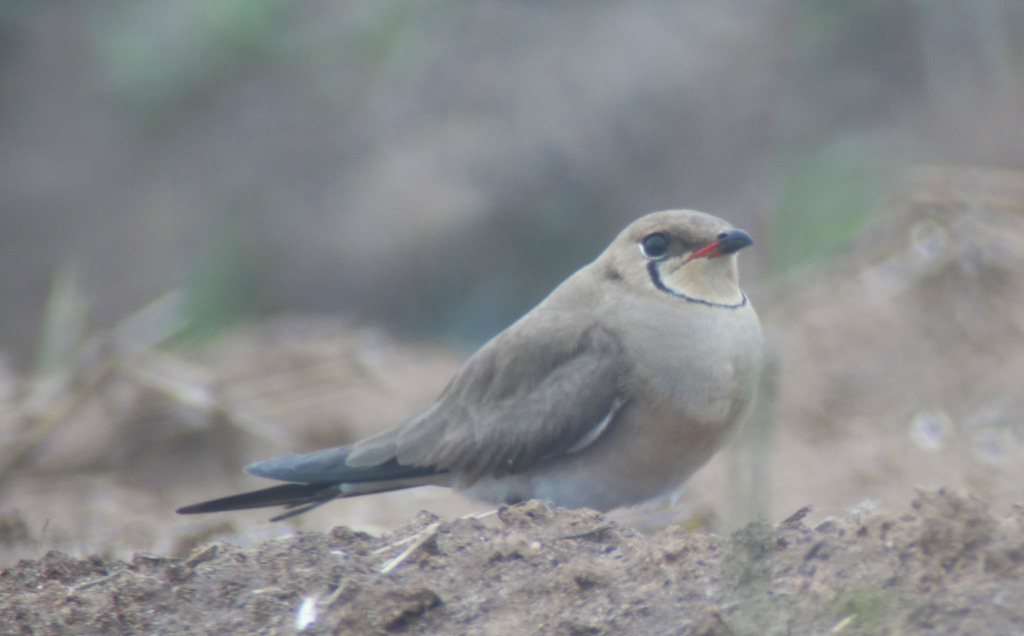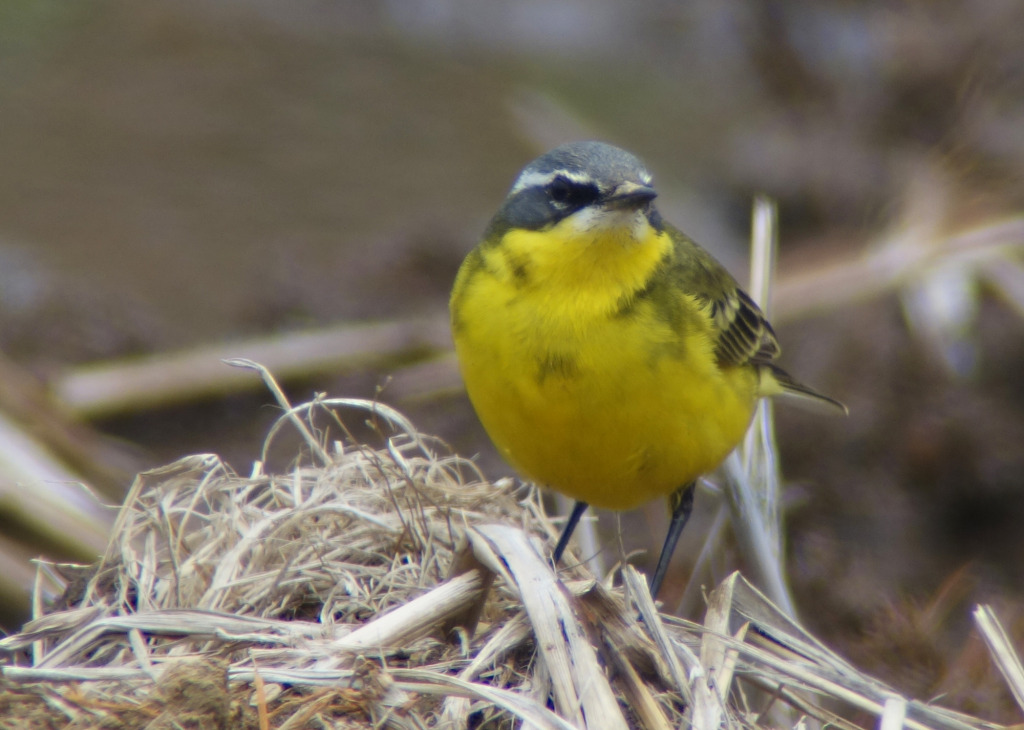Selected Bird News from Nial Moores (with Tim Edelsten for part of 12th and 13th)
Although rather more detailed reports will be posted later, about 130 species were recorded by NM during 12th-14th, including several taxa of special note (tentatively identified Booted Eagle, single Rufous-bellied Woodpecker, Alpine Leaf Warbler and Green-backed Flycatcher, and two or more “plexa” Western Yellow Wagtail).
Following the heavy rain from the evening of the 11th until about 3AM on the 12th, winds remained strong (8-11m / second) on 12th and 13th, though regrettably stubbornly between southwest and south or even southeast on all three days, with largely overcast and misty weather giving way to afternoon sunshine and exceptionally good visibility on the 12th; sunny weather through the 13th, with visibility falling to about 3km in the afternoon; and dense fog in the morning of the 14th, eventually giving way to hazy sunshine.
Areas visited included Junghwadong (from 06:30 on both 12th and 13th with TE), Yeonhwa (from about 10:10-14:50 on 13th) mostly with TE; and Jincheon.
Species of greatest note (with all images digiscoped through a superb Swarovski scope, and most counts approximate) included:
Chinese Pond Heron Ardeola bacchus. Two on 12th; ten on 13th; and 8+ in Jincheon on 14th.
Chinese Egret Egretta eulophotes. One was watched feeding successfully in wet rice-fields in Jincheon on 14th (the contrast between more traditional life-rich fields, with ponds in their corners as used by this egret, and newer fields with unnecessarily deep, steep-sided concrete drains – presumably a death-trap for thousands of frogs and other rice-field biota – is quite remarkable and tragic).
 Chinese Egret Egretta eulophotes © Nial Moores
Chinese Egret Egretta eulophotes © Nial Moores
Booted Eagle Hieraaetus pennatus (?). A raptor which overflew us and soon disappeared eastward into the mist and murk at about 8AM on the 12th was tentatively identified as this species, with final identification to be decided later after proper review of understandably poor flight images taken by TE (which will be posted later). Features noted at the time of the sighting included: An aquila-type feel, with straight leading edge to the wing, and some secondary bulge; a long, straight-sided, thin-looking and straight-ended tail, often “switched”; a short neck and blunt looking head; medium-length primary “fingers” flexed slightly upward when gliding on straight or slightly bowed wings; an overall dark brown plumage below; and a strikingly pale band across the median coverts on the upper side of the wing, seen at distance as the bird finally banked (when it was seen to join two other large-looking raptors too distant to ID). The images (as seen on the camera monitor) appear to show the wing-shape, the thinness of the tail, and two features not noted (by NM at least) in the field: a perhaps warmer, rusty-brown tone to the vent etc; and a pale, silvery underside to the tail, with a diffuse dark terminal tip (both features that seem often to be shown by dark morph Booted Eagle).
Oriental Pratincole Glareola maldivarum. Two in Jincheon on the 13th and 14th (one was seen in the same area on the 11th by TE).
 Oriental Pratincole Glareola maldivarum © Nial Moores
Oriental Pratincole Glareola maldivarum © Nial Moores
Rufous-bellied Woodpecker Dendrocopos hyperythrus. One was seen briefly in flight in Yeonhwa Ri on 13th (NM only).
Amur Falcon Falco amurensis. Two in Junghwadong (one male and one female, latter only by TE) on 12th and one high over Yeonhwa on 13th.
 Amur Falcon Falco amurensis © Nial Moores
Amur Falcon Falco amurensis © Nial Moores
Brown Shrike Lanius cristatus. Twenty-three on 12th; 26 on 13th; and 8 on 14th. This total included one fine-looking lucionensis (in Junghwadong on 12th and 13th), with an appropriately ash-grey crown (despite it still retaining a very few bars on the lower flanks); a few lucionensis-types (with some grey on the forehead only, and browner crown, perhaps better considered as confusus?); one probable cristatus (though the extent of white on the forehead might also put it closer to confusus?); and the remainder “obvious” confusus. Based on a recent post to BirdForum by Tom Beeke in Liaoning, “real” lucionensis now seems to be as rare there as it has now become in the ROK.
 Brown Shrike Lanius cristatus lucionensis © Nial Moores
Brown Shrike Lanius cristatus lucionensis © Nial Moores
 Brown Shrike Lanius cristatus, presumed cristatus with confusus behind © Nial Moores
Brown Shrike Lanius cristatus, presumed cristatus with confusus behind © Nial Moores
Black-naped Oriole Oriolus chinensis. Following the large departure of the 11th, only one on 12th; 26 on 13th (with almost all of these in the early evening); and 15 on 14th.
Black Drongo Dicrurus macrocercus. One drongo sp. on 12th; five on 13th; and in Jincheon on 14th, eleven.
“Manchurian Bush Warbler” Horornis sp. In addition to several Korean Bush Warbler Horornis borealis daily, one individual appeared strikingly different, in that it was closer in size to a Japanese Bush Warbler H. diphone and looked proportionately almost as long-tailed; was reddish-brown above (not just chestnut-capped), much warmer-looking than borealis; had a strikingly white supercilium; and pale-looking underparts. Its call also sounded subtly different to borealis, a softer “prrt”. An exceptional borealis or perhaps a small-end female nominate canturians (now surprisingly lumped by some back in with Japanese Bush Warbler!)?
Alpine Leaf Warbler Phylloscopus occisinensis. On 12th, one heard calling and even giving one or two song-phrases, was glimpsed by both NM and TE in Junghwadong for a few seconds before disappearing, apparently “up island”.
Hume’s Leaf Warbler Phylloscopus humei. Although not heard, one was identified on plumage in Junghwadong on 12th (NM and TE).
Chestnut-flanked White-eye Zosterops erythropleurus. One of the more numerous land bird migrants on the island, with c. 300 on 12th, 100 on 13th and 100+ on 14th. Most are in fast-moving flocks, with feeding birds apparently difficult to approach unless in fog or at dusk.
 Chestnut-flanked White-eye Zosterops erythropleurus © Nial Moores
Chestnut-flanked White-eye Zosterops erythropleurus © Nial Moores
Chinese Blackbird Turdus mandarinus. One, or more probably two, of this “full species” (split by the IOC in early 2015) was in Junghwadong on 13th.
Grey-streaked Flycatcher Muscicapa griseisticta. Marginally the commonest flycatcher with 20 on 12th; 43 on 13th; and ten on 14th.
 Grey-streaked Flycatcher Muscicapa griseisticta © Nial Moores
Grey-streaked Flycatcher Muscicapa griseisticta © Nial Moores
Green-backed Flycatcher Ficedula elisae. One on 13th in Jincheon (NM only). Although seen for only 2-3 seconds, this female narcissus-type flycatcher, with strongly yellow underparts, bright green upperparts, a staring yellow eye-ring, a weak wing-bar and no yellow on the rump was confidently identified as this species.
Western Yellow Wagtail Motacilla flava thunbergi. On 12th, two dark-headed wagtails seen in Jincheon (independently by TE and NM) showed multiple features of “plexa”. Although only very poorly digiscoped, in the field both lacked any blueish-grey tones to the head (appearing more slaty-grey on the crown); both had weak supercilia (strongest behind the eye, and broken before it); blackish lores; one had dark-grey extending up on the forehead (darkest directly above the bill); and the other had a strong necklace. They thus appeared markedly different from the tschutschensis seen with them; and each showed two or more features not expected in macronyx (i.e a weak supercilium; dark onto the forehead; and a breast necklace). Single “plexa” were also found (by NM) in different fields in Jincheon on 13th and 14th (images could not be taken so it is unclear whether these were the same or were different birds), and one bird heard on the 14th seemed to give a call that was less harsh than accompanying Eastern Yellows. I used to see one or two “plexa” each spring on West Sea islands in the early 2000s, but these were probably my first since ~2005 (?); and few other birders in the ROK seem to be claiming them either, perhaps especially since “plexa” has been reassigned to Western Yellow Wagtail.
 Western Yellow Wagtail Motacilla flava thunbergi: individual one © Nial Moores
Western Yellow Wagtail Motacilla flava thunbergi: individual one © Nial Moores
 Western Yellow Wagtail Motacilla flava thunbergi: individual two © Nial Moores
Western Yellow Wagtail Motacilla flava thunbergi: individual two © Nial Moores
Eastern Yellow Wagtail Motacilla tschutschensis. Nine on 12th; 112+ on 13th; and 30+ on 14th. The vast majority were of the nominate subspecies, with only one or two macronyx (on 13th); and approximately five (on 13th) to eight (on 14th) taivana.
 Eastern Yellow Wagtail Motacilla tschutschensis tschutschensis © Nial Moores
Eastern Yellow Wagtail Motacilla tschutschensis tschutschensis © Nial Moores
 Eastern Yellow Wagtail Motacilla tschutschensis taivana (Female) © Nial Moores
Eastern Yellow Wagtail Motacilla tschutschensis taivana (Female) © Nial Moores
 Eastern Yellow Wagtail Motacilla tschutschensis macronyx (Yeonhwa, Baekryeong Island, May 2014) © Nial Moores
Eastern Yellow Wagtail Motacilla tschutschensis macronyx (Yeonhwa, Baekryeong Island, May 2014) © Nial Moores
Citrine Wagtail Motacilla citreola. One male in Jincheon on 12th.
 Citrine Wagtail Motacilla citreola © Nial Moores
Citrine Wagtail Motacilla citreola © Nial Moores
Meadow Bunting Emberiza cioides. Birds apparently in territory at several sites on the island – including areas much “altered” even since last year.
 Meadow Bunting Emberiza cioides © Nial Moores
Meadow Bunting Emberiza cioides © Nial Moores
Yellow-breasted Bunting Emberiza aureola. Two on 12th; 15 on 13th; and two on 14th.
Yellow Bunting Emberiza sulphurata. 1+ in Jincheon on 12th (NM only); and one on 13th in Yeonhwa Ri (NM and TE).


